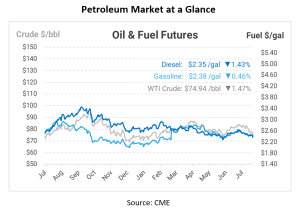
Oil Prices Near Seven-Week Low Amid China Demand Concerns and Geopolitical Tensions
Oil prices held steady near their lowest levels since early June on Tuesday, as mixed signals about global demand were balanced by a Chinese government pledge to support the economy and expectations of lower U.S. crude inventories.
China, the world’s largest crude importer, has recently provided a string of disappointing economic data. According to a Reuters poll, China’s manufacturing activity likely shrank for the third consecutive month in July. This trend has been a significant drag on commodity prices, including oil.
On Tuesday, Brent crude slipped by 16 cents, or 0.2%, to $79.62 a barrel, having fallen intraday to $79.34, its lowest since June 10. Similarly, U.S. crude was down 11 cents, or 0.2%, at $75.70.
“Macroeconomic considerations keep shaping investors’ sentiment,” noted Tamas Varga from oil broker PVM. “Chinese economic turmoil, including sluggish growth and falling crude oil imports, is still a major driving force for our market.”
Despite Chinese leaders’ promises to bolster economic support, the extent of these measures remains uncertain. The Third Plenum policy meeting in mid-July largely reiterated existing economic policy goals without introducing significant new initiatives.
In the geopolitical arena, oil prices had fallen 2% in the previous session following Israel’s restrained response to a rocket strike in the Israeli-occupied Golan Heights. This approach aimed to avoid escalating tensions in the Middle East into a broader conflict.
In Venezuela, the opposition claimed victory with 73% of the vote in Sunday’s presidential election, despite the national electoral authority declaring incumbent Nicolas Maduro the winner. According to ANZ analysts, This political instability could tighten U.S. sanctions on Venezuela, potentially reducing the country’s oil exports by 100,000-120,000 barrels per day.
An OPEC+ panel is set to meet on Thursday to review the market and the plan to begin unwinding some output cuts starting in October. However, no changes are currently expected.
U.S. Oil Inventory and Production Updates
The latest reports expect U.S. crude and fuel stockpiles to show lower levels, potentially supporting oil prices. Additionally, Exxon is working to restart its Joliet refinery in Illinois, which has a refining capacity of 252,000 barrels per day, after a two-week outage due to a power loss.
The Biden administration announced on Monday the purchase of 4.65 million barrels of crude oil for the nation’s emergency reserve as it continues to refill the depleted stockpile.
Despite these developments, oil futures slid nearly 2% to a seven-week low by closing trading in the U.S. on Monday. The Brent front-month futures contract ended down 1.66% at $79.78 per barrel, while West Texas Intermediate (WTI) closed down 1.75% at $75.81 per barrel.
This decline follows a three-week losing streak for oil, driven by concerns over global demand and a lack of economic turnaround signals from China. The market is also cautious about the Northern Hemisphere’s summer demand and the U.S. economic outlook.
China’s General Administration of Customs reported a significant drop in the country’s fuel oil imports, down 11% in the first half of 2024. This decline sparked a round of selling as traders worried about the market direction in the world’s largest crude importer.
OPEC is set to unwind its production cuts later this year, with forecasts of an oil market surplus rising. The International Energy Agency (IEA) anticipates strong global supply growth in 2025, led by non-OPEC output from the U.S., Canada, Guyana, and Brazil.
In the current market environment, Brent crude remains in backwardation, where current prices are higher than future prices. On Monday, the difference between the Brent April and May 2025 contracts and the September contract was over $3 per barrel, reflecting ongoing concerns about global demand.

This article is part of Daily Market News & Insights
Tagged:
MARKET CONDITION REPORT - DISCLAIMER
The information contained herein is derived from sources believed to be reliable; however, this information is not guaranteed as to its accuracy or completeness. Furthermore, no responsibility is assumed for use of this material and no express or implied warranties or guarantees are made. This material and any view or comment expressed herein are provided for informational purposes only and should not be construed in any way as an inducement or recommendation to buy or sell products, commodity futures or options contracts.





